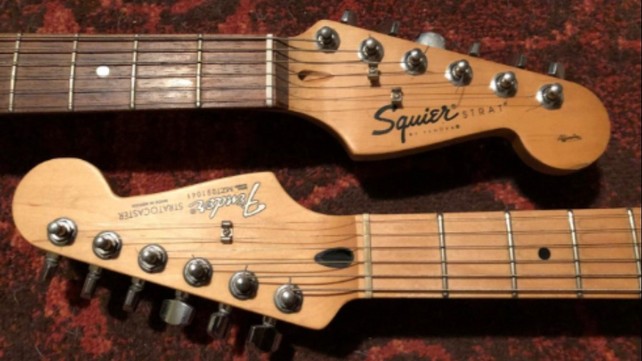Painting a Guitar? What’s The REAL Difference Between a Fender and Squire Guitar?
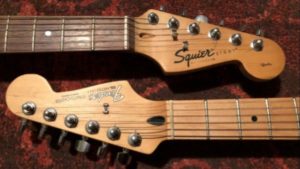
OK so you want to custom paint or detail a guitars and are wondering weather you should save money by simply buying Fender Squires or other ‘replica’ style guitars of your favourite models. So let’s look at Squire guitars and see what the real difference between a standard Fender guitar and a Squire Fender guitar (Squires have two sub-types called Bullet and Affinity series – each of which have their own lower and higher quality characteristics).
What is a Fender Squire?
Originally the was just Fender guitars started in the 50’s. Then a few years later many Fender acquired the brand Squire. Then a bit later companies started ‘knocking off Fender clones – a few very good – some average – but mostly awful to play and tune etc. To get back (rightfully) some of the market share they lost as guitar makers everywhere took advantage of Leo Fender’s incredible design.
So nowadays there are 2 types of guitars that Fender guitar makes – and these 2 can be further broken down into two more categories each. They aim them at amateur markets and the professional. They are:
- Fender
– their original ‘standard’ guitars (reasonable priced for professionals)
– their ‘custom-shop’ guitars (very expensive for professionals - Fender Squire
– aimed at amateurs on a budget (but used by many people professionaly)
– aimed at ‘beginners’ on a really tight budget
Now the fact that the squires are so well made that professionals often play them begs the question – why buy an original Fender at all? Well – the answer is several.
- Fender use their more expensive woods for the more expensive models according to their ears and experience.
- Fender spend more time setting up their guitars and the custom shop ones – well they’re as good as it gets.
- Yes – you DO pay more for that name on the headstock – but why shouldn’t you? Fender have earned their right to be king and they certainly don’t rip people off. It’s arguable wether the super-expensive ones are really worth the money but they are shorter runs (meaning more costly to produce) have hardware and features on the others don’t and – well… something is worth only as much as someone is willing to pay for it and they don’t hold a gun to anyone’s head right?
So what does all this mean? Well luckily for us it means with a little TLC we can still get a great sounding and very well made guitar for unbelievably little amount from Fender. How is this done?.. well once upon a time guitars knocked out in these volumes by favorties were hi and miss – but with todays’ computer controlled lathes – and parts all cut EXACTLY the same shape and size the only thing that can setu you back is shoddy setup and the quality – and in the Squire case – thickness/amount) of the wood. These are the ways that Fender manages to give everyone a great deal weather you are top or bottom in the wallet wars!
Yes there is a LOT of BS on the web about guitars – tones – woods – pickups – a lot. But the truth is mixed in there somewhere. I don’t want t spoil the magic or the fun but come on – we need to get real – a good piece of wood is a good piece of wood – lets get on with the playing and if it don’t sound right – change it! And hers’s the proof I’m not bs’ing you – I use them myself and I use them to create my ‘Artisan and Bohemian’ custom range. And add to that I never let a guitar out of my workshop that I don’t want to keep!
Re-write…
BS example from a forum
The main difference is in the price and the quality. The fender guitars are more expensive and tend to be of higher quality, whereas Squier guitars are made more cheaply and have lower quality. By this I don’t mean that the Squier guitars are low quality and bad, but (usually) they are not so good as a Fender guitar.
By good and low quality, I refer mostly to the sound, the playability and the durability of the guitar. A high quality guitar will be able to produce a high quality sound, whereas a low quality guitar’s sound will not. Similarly, a low quality guitar might not be that easy to play. Using low quality woods might cause pain on your arm, whereas a high quality guitar will have woods that are comfortable for your hands, so you can play for hours without getting any pain. Lastly, a low quality guitar isn’t made to last a lifetime.
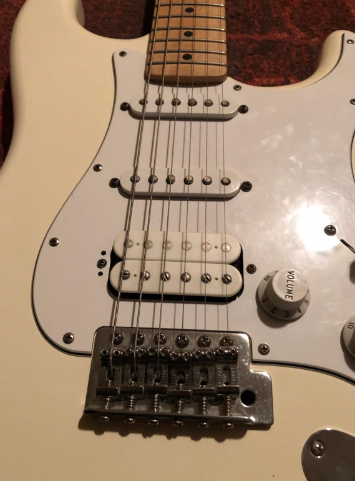
The Squier Stratocasters were made to the exact same specs as the Fenders as they were licensed by Fender. Bodies and necks are cut out by CNC machines set to the same specs. However, the wood used for Fenders is generally a higher grade than on Squiers, of course there is some variation with that as well. Fenders are typically made of Alder or Ash, there are some variations which use mahogany or basswood. Certain players prefer certain tonewoods – Pete Loeffler of Chevelle uses mahogany bodied Stratocasters. Squier guitars may also use alder, ash, or basswood. I’ve even heard rumors of mahogany and mahogany variants being used in a Squier as well. But generally its basswood or poplar or agathis, which are typically much cheaper, especially in Japan where they are readily available. Many modern players prefer basswood bodies in their guitars. Again, when the blanks of wood that will eventually become guitar bodies are graded, Fender gets the pick of the litter – the high grade blanks. Squier guitars aren’t as picky about wood quality. Depending on where you want your tone coming from, this can be a factor or not. If you’re someone who like to use modulation to shape your tone in a controlled setting – and you want the pure tone of the string vibrating, then wood quality doesn’t matter as much as if you like your tone to show the character of the guitar its self – its acoustic properties, resonance, ect. Most guitarists prefer the latter. But let us not forget that even lesser quality wood will have its own character and acoustic properties.
So, let’s get down to brass tacks here, let’s compare the specs for a 2018 Fender American Strat and a 2018 Squier Strat.
The Fender American Professional Stratocaster sports a body made of Alder (or optional Ash), a bone nut, V-Mod single coil pickups, maple or rosewood fretboards, and a 2 point Tremelo with a copper infused 100% metal high mass block. This added mass is important for added sustain. It also features a treble bleed circuit, which is meant to retain highs when rolling off the volume – some like that wiring, some prefer to have some roll-off and use their volume knob to control tone as well. The price is $1449.
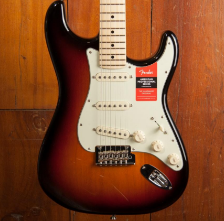
The Squier Stratocaster features an agathis body, synthetic nut, Fender stock pickups, a fretboard made of Maple or Indian Laurel, and a 2 point tremolo system without the same high mass block. It should be noted that the Vintage Series Squiers use Duncan designed SC-101 pickups, which is a decent upgrade from the stock Fenders. The price tag for the Standard Stratocaster is $299.
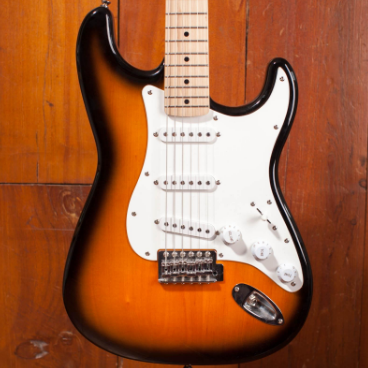
So it would seem that the Fender is, indeed a higher quality instrument. The biggest disparities between the Fender and the Squier would be the tremolo system, the pickups, and the tonewood used on the body. Another thing the specs won’t tell us is the quality control. There is much more quality control that goes on at the end of production on Fenders than Squiers. The most common areas of concern are the frets, particularly the fret ends, the nut grooves, and the overall setup, especially the tremolo. Fenders also feature a higher quality truss rod, something that techs will appreciate but most players won’t give a second thought to. However, many Squiers come off the line as wonderful instruments, especially if you are just starting out or if you plan to customize your instrument. Fender will typically give you a quality instrument right off the line that is set up and ready to rock. The choice is yours.
